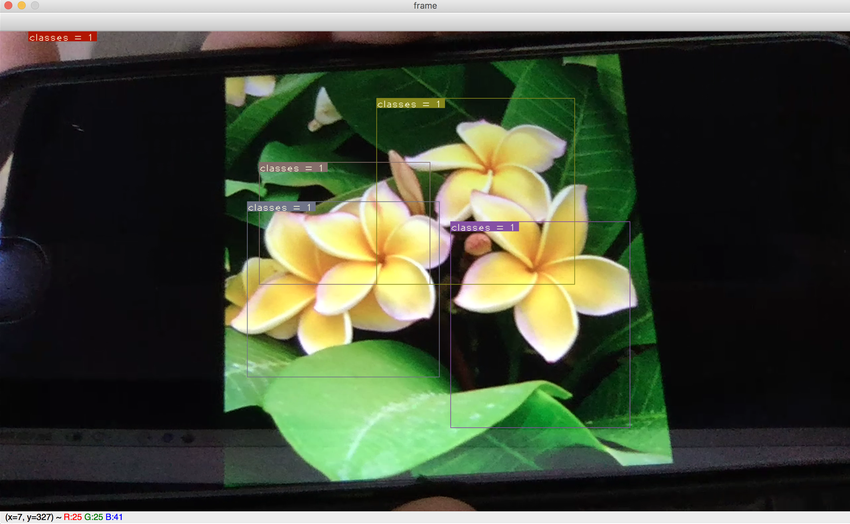This fork is a work in progress. It will be noted here when this is ready for broader, more production, use.
Status (going well, main stuff done):
- Replace CUDA flag in lieu of the simple
tensor_xyz.to(device)method - Fix
customloader.pyto take multiple classes as an argument - Add a custom collate function to
train.pyto detect empty boxes and exclude - Fix resizing transform by creating a custom
YoloResizetransform calledYoloResizeTransform - Add finetuning to the
train.pyscript
- Fix the learning rate adjustment to decrease more consistently during training and finetuning
- Fix
customloader.pyto take custom (as an argument) anchors, anchor numbers and model input dims - Ensure
live.pyis correctly drawing bounding boxes - Ensure this codebase works with full sized YOLOv3 network (only tested with the tiny architecture)
- flake8 (clean up extra blank lines, long lines, etc.)
- Remove
*imports in place of explicit imports
We love you COCO, but we have our own interests now.
This project is a "You Only Look Once" v3 sample using PyTorch, a fork of https://github.com/ayooshkathuria/pytorch-yolo-v3, with updates and improvements specifically for the Tiny architecture on custom data labeled with VoTT (versus the classic download of VOC or COCO data and labels). This fork allows the user to bring their own dataset.
Note: This project is a work in progress.
- Install the required Python packages (
pip install -r requirements.txt). - Download the full YOLO v3 (237 MB) or tiny YOLO v3 (33.8 MB) model. Fun fact: this project utilizes the weights originating in Darknet format.
- Use the VoTT labeling tool to create bounding boxes around objects of interest in images and export to YOLO format. The
dataoutput folder should be a subdirectory here with the images, labels and pointer file. - If you wish to train on all labeled images, make sure they are all in the
train.txtfile (this is read by thecustomloader.py).
Filters
Ensure the yolov3-tiny.cfg is set up to train (see first lines of file). Note, the number of classes will affect the last convolutional layer filter numbers (conv layers before the yolo layer) as well as the yolo layers themselves - so will need to be modified manually to suit the needs of the user.
Modify the filter number of the CNN layer directly before each [yolo] layer to be: filters=(classes + 5)x3. So, if classes=1 then should be filters=18. If classes=2 then write filters=21, and so on.
Anchors
The tiny architecture has 6 anchors, whereas, the non-tiny or full sized YOLOv3 architecture has 9 anchors. These anchors should be manually discovered with kmeans.py and specified in the cfg file.
Additional Instructions
- Create a list of the training images file paths, one per line, called
train.txtand place it in thedatafolder. e.g.
train.txt
data/obj/482133.JPG
data/obj/482128.JPG
data/obj/482945.jpg
data/obj/483153.JPG
data/obj/481427.jpg
data/obj/480836.jpg
data/obj/483522.JPG
data/obj/482535.JPG
data/obj/483510.JPG
Cmd (this will be for one-class detector):
python train.py --cfg cfg/yolov3-tiny.cfg --weights yolov3-tiny.weights --datacfg data/obj.data
Usage:
python train.py --help
Here, you will use your trained model in a live video feed. Ensure the yolov3-tiny.cfg is set up to test (see first lines of file). runs is where trained models get saved by default.
Additional Instructions
- Create a list of the test images file paths, one per line, called
test.txtand place it in thedatafolder. e.g.
test.txt
data/obj/482308.JPG
data/obj/483367.JPG
data/obj/483037.jpg
data/obj/481962.JPG
data/obj/481472.jpg
data/obj/483303.JPG
data/obj/483326.JPG
Cmd:
python live.py --cfg cfg/yolov3-tiny.cfg --weights runs/<your trained model>.pth --datacfg data/obj.data --confidence 0.6
Usage:
python live.py --help
- Custom data possibility
- Clean up of several portions of code and generalizing/parameterizing
- YOLOv3: You Only Look Once v3. Improvments over v1, v2 and YOLO9000 which include Ref:
- Predicts more bounding boxes per image (hence a bit slower)
- Detections at 3 scales
- Addressed issue of detecting small objects
- New loss function (cross-entropy replaces squared error terms)
- Can perform multi-label classification (no more mutually exclusive labels)
- Performance on par with other architectures (a bit faster than SSD, even)
- Tiny-YOLOv3: A reduced network architecture for smaller models designed for mobile, IoT and edge device scenarios
- Anchors: There are 5 anchors per box. The anchor boxes are designed for a specific dataset using K-means clustering, i.e., a custom dataset must use K-means clustering to generate anchor boxes. It does not assume the aspect ratios or shapes of the boxes. Ref
- Loss,
loss.backward()andnn.MSELoss(for loss confidence): Mean Squared Error - IOU: intersection over union between predicted bounding boxes and ground truth boxes
The original YOLOv3 paper by Joseph Redmon and Ali Farhadi: https://arxiv.org/pdf/1804.02767.pdf
